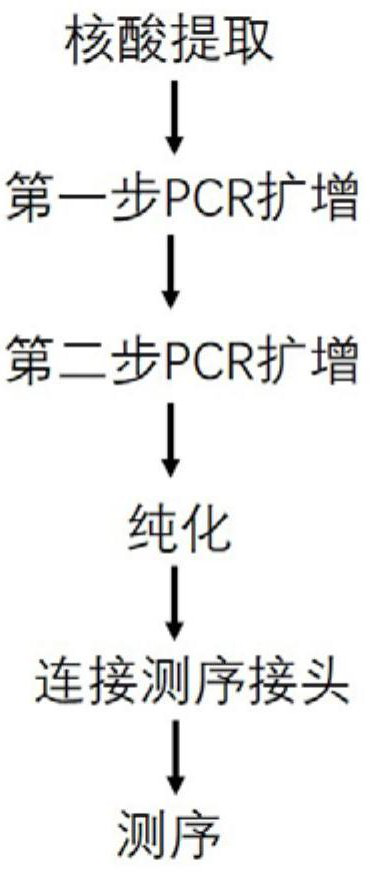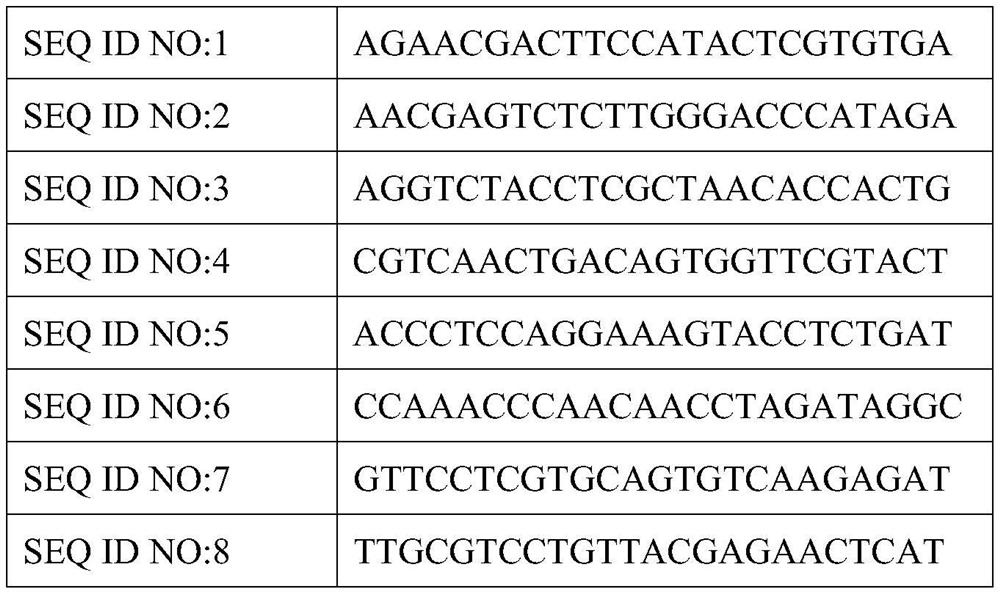Primer combination and application for nanopore sequencing library construction of a respiratory pathogen
A technology of nanopore sequencing and primer combination, which is applied in the field of detection of respiratory pathogens, can solve the problems of long circulation period, cumbersome operation process, and many operation steps, and achieve the effect of accurate identification and identification, cumbersome operation process and simple operation steps
- Summary
- Abstract
- Description
- Claims
- Application Information
AI Technical Summary
Problems solved by technology
Method used
Image
Examples
Embodiment 1
[0050] Example 1 A primer combination for library construction based on nanopore sequencing
[0051] Including sequence (1) to sequence (5), each sequence is composed of segment a sequence, segment b sequence and segment c sequence from the 5' end to the 3' end;
[0052] Wherein the sequence (1) to sequence (5) is consistent with the b-section sequence, the nucleotides of the sequence are as shown in any one of SEQ ID NO: 1-108;
[0053] The nucleotides of sequence (1) to segment c of sequence (5) are shown in sequence as SEQ ID NO: 109-113;
[0054] The sequence nucleotides of sequence (1), sequence (3) and sequence (4) in sequence (a) are shown in SEQ ID NO: 114, and the sequence nucleotides in sequence (2) and sequence (5) in sequence (a) are as shown in SEQ ID NO : 115.
[0055] The sequence is detailed in Table 1:
[0056] Table 1
[0057]
[0058]
[0059]
[0060]
[0061]
[0062]According to the above rules, there will be a total of 108 different pr...
Embodiment 2
[0107] Example 2 A method for building a library based on nanopore sequencing
[0108] Operation process such as figure 1 As shown, the extracted and purified nucleic acid is a library after two steps of PCR amplification, product purification, and sequencing adapter connection, which can be directly used on the machine for real-time data analysis. The specific experimental steps are as follows:
[0109] 1. DNA extraction and purification
[0110] The nucleic acid extraction kit (DP710-T6B) of Tiangen Biochemical Technology Co., Ltd. was used for extraction and purification.
[0111] (1) Lysis and digestion of alveolar lavage fluid samples
[0112] Samples Take 500 μl of the sample and place it in a 2ml EP tube, add 500 μl of lysate GHH-A and 50 μl of Proteinase K respectively, vortex and shake to mix, and bathe in 65°C water bath for 20 minutes.
[0113] (2) Glass bead mill
[0114] 1) Take 1000 μl of the lysed and digested sample and place it on a bead mill for grinding ...
Embodiment 3
[0174] Example 3 Nanopore sequencing of alveolar lavage fluid samples
[0175] 1. Experimental method
[0176] Using the method in Example 2, the nanopore sequencing of 24 cases of alveolar lavage fluid samples, the samples were numbered 1-24, and the samples numbered 1-12 used the primer combination 1 in Example 1 for the first multiplex PCR Amplification, samples numbered 13-24 were amplified using primer combination 2 in Example 1 for the first multiplex PCR amplification.
[0177] During the second PCR amplification, samples numbered 1-12 were added to BP1-BP12 in turn, and samples numbered 13-24 were added to BP1-BP12 in turn.
[0178] 2. Experimental results
[0179] The causative pathogens detected in each sample are shown in Table 2.
[0180] Table 2:
[0181]
[0182]
[0183] The fragment distribution of nanopore sequencing reads is as follows figure 2 As shown, the peaks at 600bp and 1500bp correspond to the amplified bands of fungal ITS and bacterial 16...
PUM
 Login to View More
Login to View More Abstract
Description
Claims
Application Information
 Login to View More
Login to View More - R&D
- Intellectual Property
- Life Sciences
- Materials
- Tech Scout
- Unparalleled Data Quality
- Higher Quality Content
- 60% Fewer Hallucinations
Browse by: Latest US Patents, China's latest patents, Technical Efficacy Thesaurus, Application Domain, Technology Topic, Popular Technical Reports.
© 2025 PatSnap. All rights reserved.Legal|Privacy policy|Modern Slavery Act Transparency Statement|Sitemap|About US| Contact US: help@patsnap.com



